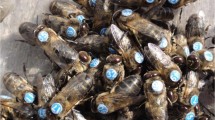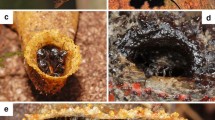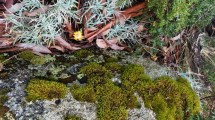Summary
Free flying drone bees (Apis mellifera carnia (μ) were filmed from the side while chasing the honey bee queen or landing on a hive.
Drones use the upper frontal part of the field of view of their eyes while chasing the queen. They fixate with the lower frontal part of the field of view of their eyes during landing. Drones keep a particular distance from the queen while chasing her.
The diameter of ommatidial lenses in drones shows a maximum in the region where the queen is fixated.
Similar content being viewed by others
References
Alber, M., Jordan, R., Ruttner, H.: Von der Paarung der Honigbiene. Z. Bienenforsch.3, 1–28 (1955)
Autrum, H., Zwehl, V. von: Zur spektralen Empfindlichkeit einzelner Sehzellen der Drohne (Apis mellifica). Z. Vergl. Physiol.46, 8–12 (1962)
Autrum, H., Zwehl, V. von: Die spektrale Empfindlichkeit einzelner Sehzellen des Bienenauges. Z. Vergl. Physiol.48, 357–384 (1964)
Butler, C.G.: A sex attractant acting as an aphrodisiac in the honeybee (Apis melifera L.). Proc. R. Ent. Soc. (London), A 71–76 (1967)
Butler, C.G., Fairey, E.M.: Pheromones of the honeybee: Biological studies of the mandibular gland secretion of the queen. J. Apic. Res.3, 65–76 (1964)
Collett, T.S., Land, M.F.: Visual control of flight behaviour in the hoverfly,Syritta, pipiens L. J. Comp. Physiol.99, 1–66 (1975a)
Collett, T.S., Land, M.F.: Visual spatial memory in a hoverfly. J. Comp. Physiol.100, 59–84 (1975 b)
Collett, T.S., Land, M.F.: How hoverflies compute interception courses. J. Comp. Physiol.125, 191–204 (1978)
Cooper, B.A.: Have you heard a drone assembly? Ed.: British Isles Bee Breeders' Association, Whitegates, Thulston (1977)
Esch, H., Nachtigall, W., Kogge, S.N.: Correlations between aerodynamic output, electrical activity in the indirect flight muscles and wing positions of bees flying in a servomechanically controlled wind tunnel. J. Comp. Physiol.100, 147–159 (1975)
Franceschini, N.: Sampling of the visual environment by the compound eye of the fly: Fundamentals and applications. In: Photoreceptor optics. Snyder, A.W., Menzel, R. (eds.), pp. 98–125. Berlin, Heidelberg, New York: Springer 1975
Franceschini, N.: Sex-spezifische Photorezeptorzellen im Fliegenauge. Abstract: Jahrestagung der deutschen Neurobiologen, 1979
Gary, N.E.: Chemical mating attractants in the queen honey bee. Science136, 773–774 (1962)
Gary, N.E., Marston, J.: Mating behaviour of drone honey bees with queen models (Apis mellifera L.). Anim. Behav.19, 299–304 (1971)
Gerig, L.: Wie Drohnen auf Königinnenattrappen reagieren. Schweiz. Bienenztg.94, 558–561 (1971)
Hausen, K., Strausfeld, N.J.: Sexually dimorphic interneuron arrangements in the fly visual system. Proc. R. Soc. (London), Biol. (in press)
Hauser, H.: Vergleichend quantitative Untersuchungen an den Sehganglien der FliegenMusca domestica undDrosophila melanogaster. Dissertation, Eberhard-Karls-Universität, Tübingen (1975)
Jean-Prost, P.: Zusammenfassung der über den Hochzeitsflug der Königinnen angestellten Beobachtungen. Apimondia XIVV, Rom 1958. S. 58
Kirmse, W., Lässig, P.: Strukturanalogie zwischen dem System der horizontalen Blickbewegungen der Augen beim Menschen und dem System der Blickbewegungen des Kopfes bei Insekten mit Fixationsreaktionen. Biol. Zentralbl.90, 176–193 (1971)
Kirschfeld, K., Wenk, P.: The dorsal compound eye of simuliid flies. Z. Naturforsch. 31 c, 764–765 (1976)
Land, M.F., Collett, T.S.: Chasing behaviour of houseflies (Fannia c.): A description and analysis. J. Comp. Physiol.89, 331–357 (1974)
Nachtigall, W., Widmann, R., Renner, M.: Über den „ortsfesten“ freien Flug von Bienen in einem Saugkanal. Apidologie2, 271–282 (1971)
Praagh, J.P. van, Arendse, M.C., Ruttner, F.: Messung und Charakteristik von Leucht-oder Strahlungsfeldern an Drohnensammelplätzen (Apis mellifera μ). Verh. Dtsch. Zool. Ges.1976, 273 (1976)
Reichardt, W., Poggio, T.: Visual control of orientation behaviour in the fly. Part I. A quantitative analysis. Q. Rev. Biophys.9, 311–375 (1976)
Ribi, W.A.: A unique Hymenopteran compound eye. The retina fine structure of the digger WaspSphex cognatus Smith (Hymenoptera, Sphecidae). Zool. Jb. Anat.100, 299–342 (1978)
Ruttner, F., Ruttner, H.: Untersuchungen über die Flugaktivität und das Paarungsverhalten der Drohnen. III. Flugweite und Flugrichtung der Drohnen. Z. Bienenforsch.8 (9), 332–354 (1966)
Ruttner, F., Ruttner, H.: Untersuchungen über die Flugaktivität und das Paarungsverhalten der Drohnen. V. Drohnensammelplätze und Paarungsdistanz. Apidologia3, 203–232 (1972)
Strang, G.E.: A study of honey bee drone attraction in the mating response. J. Econ. Ent.63, 641–645 (1970)
Wehner, R., Flatt, I.: Visual fixation in freely flying bee. Z. Natur forsch. 32c, 409–471 (1977)
Wehrhahn, C.: Sex-specific differences in the chasing behaviour of free flying houseflies (Musca). Biol. Cybern.32, 239–241 (1979)
Weinrich, B.: Beobachtungen zum Verhalten der Drohnen (Apis mellifera) auf Bienenköniginnen-Belegstellen. Examensarbeit Celle (1978)
Woyke, J.: Multiple mating of the honeybee queen in one nuptial flight. Bull. Acad. Polon. Sci., Cl. II,3, 175–180 (1955)
Zeil, J.: A new kind of neural superposition eye: The compound eye of male Bibionidae. Nature278, 249–250 (1979)
Zmarlicki, C., Morse, R.A.: Drone congregation areas. J. Apic. Res.2, 64–68 (1963)
Author information
Authors and Affiliations
Additional information
Niedersächsisches Landesinstitut für Bienenforschung und Bienenwirtschaftliche Betriebslehre, Wehrstrasse 4, D-3100 Celle, Federal Republic of Germany
Lehrstuhl Entwicklungsphysiologie, Fakultät für Biologie, Universität Tübingen, Auf der Morgenstelle, D-7400 Tübingen, Federal Republic of Germany
We thank Walter F. Gelinski for kind cooperation and Professor W. Engels for support.
Rights and permissions
About this article
Cite this article
van Praagh, J.P., Ribi, W., Wehrhahn, C. et al. Drone bees fixate the queen with the dorsal frontal part of their compound eyes. J. Comp. Physiol. 136, 263–266 (1980). https://doi.org/10.1007/BF00657542
Accepted:
Issue Date:
DOI: https://doi.org/10.1007/BF00657542




